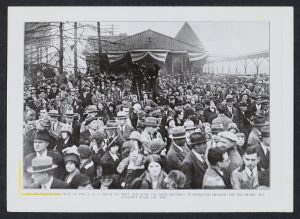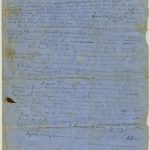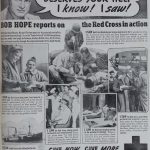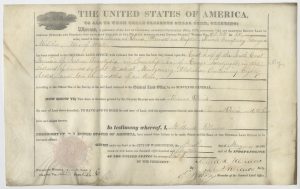During the Civil War, Mobile Bay was protected by not one but two fortifications:
- to the west — Fort Gaines, on Dauphin Island
- to the east — Fort Morgan, down the beach from Gulf Shores
From these strategic points, Confederate soldiers could prevent enemy ships from coming into the bay by firing upon them. At the very least, they could keep an eye on traffic coming into the harbor.
Though the forts are no longer being used, they are still standing. I’ve been to Fort Gaines before, and on a recent trip to the gulf coast, I visited Fort Morgan, its slightly more impressive brother. Below, I’ll share some images from that trip (and others from the present day) as well as photographs and documents from our archive that give you a sense of each fort and why it was important to the cause.
Fort Gaines
Fort Gaines was built in the wake of the war of 1812 and went through Confederate hands before returning to possession by the U.S. military. (Learn more about its history here, where you can find a video and an interactive map.)
Fort Gaines is now a museum, although the fortifications are not as well preserved as Fort Morgan’s. The island, however, is a thriving little beach community. Here are a couple of images from the island in 1940:
Here’s a view from the island in the present day:
Fort Morgan
Like its brother across the bay, Fort Morgan was constructed after the war of 1812, taken over by the Confederate Army in at the outset of the Civil War, and retaken by the Yankees near the end. After the war, it was used for various purposes by the U.S. Army and Navy. (You can read more about its history here).
- Chesterfield Cigarettes, February 1943
- Red Cross ad featuring Bob Hope, March 1945
Fort Morgan guards the east side of Mobile Bay. Here are some images from our collections showing this area in the early 20th century.
- Chesterfield Cigarettes, September 1942
- United Service Organization, October 1941
Today, Fort Morgan is a state park. You can visit the museum to learn more about how the fort operated, as well as explore the ruins and take in the nature around them, including a beach on the bay and a fishing pier.
War
In 1861, early in the Civil War, Mobile author Augusta Evans Wilson wrote to her friend, Rachel, about the Confederate possession of the fort and what it meant to her family and community:
You have doubtless heard from the papers of our taking our Forts & Arsenal. By far the most important of these is Fort Morgan, situated 30 (thirty) miles below Mobile, and commanding the entrance to our harbor. The fortifications are very strong, and with the addition of a few Columbiads which are daily expected, will be almost impregnable. … It is an anxious, terrible time – ! My Father and both my Brothers belong to the garrison of Fort Morgan and you can readily imagine, how restless their constant exposure to attack renders me.
Augusta and her friends helped out the fort in a very real way:
Immediately after its occupation by Alabama troops, the commander informed us that a number of Sand Bags, for the ramparts were needed; and also flannel charges for the cannon. We, ladies went to work at once, and have finished over 9000 Bags. this has kept me so busily engaged, that I have had no time for anything else; not even to write to you my dear friend.
At some point in the fort’s life, soldiers used this small oven to heat cannon balls, which when fired into passing ships would set them ablaze!
Early on in the war, things were probably going smoothly for the troops stationed on Mobile bay. Isaac Shelby, a commissary officer for the Military Department of the Gulf, wrote this about the state of supplies at both forts in the first half of 1862:
Despite a promising start, the forts, as part of the Confederate holdings, fared just as poorly as the rest of the Confederacy as the war went on. Both were retaken in the Battle of Mobile Bay, in August 1864. Our sister blog, Cool@Hoole, has an excellent series of posts on this battle, featuring items one can only find in the physical collections at Hoole Library.
Among digitized items about the battle, we have this letter of August 14, 1864. Valentine Bruner, a Union soldier from Maryland, tells his parents of the recent surrender of Gaines and impending surrender of Morgan:
First we have been dismounted and are acting as infantry we started from New orleans for Mobile the 1st of Aug. our land forces entirely surrounding the Forts and on the fifth Fort Powell was evacuated and on the 7th Fort Gaines surrendered with 700 hundred prisoners. oh you cannot imagine how proud you feel to see 700 men march out in front of you and stack their arms to you. … the same plan we tried at Forts Powell and gaines we are now trying on Fort Morgan the [?] are now as I write belching out their 15teen inch shell all over them It mus fall but I cannot say how long it will take…
In 1865, some months after both forts had fallen, Mobile finally surrendered. George S. Smith, part of a Union regiment from Ohio, marked the occasion (and the end of the war) in his diary:
Thankfully, Mobile survived its 19th century hardships, including the tumult of war, a terrible explosion (May 1865), Reconstruction (through 1874), and economic depression. Now, it’s the third largest city in the state, and its bay still invites ships and beachgoers alike.
- Life Savers, 1940




















